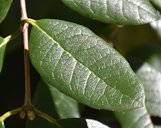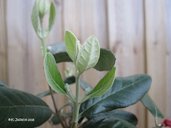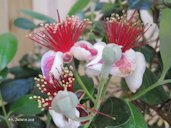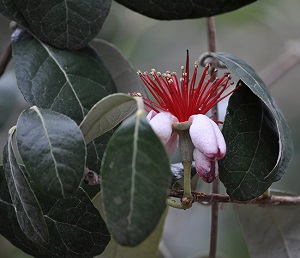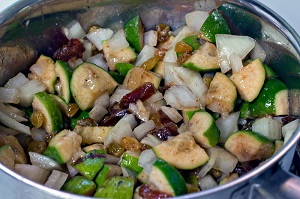| Pineapple Guava - Feijoa sellowiana | |||||||||||||||||
|---|---|---|---|---|---|---|---|---|---|---|---|---|---|---|---|---|---|
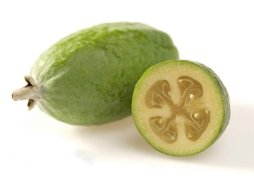 Fig. 1  Feijoa, Feijoa sellowiana 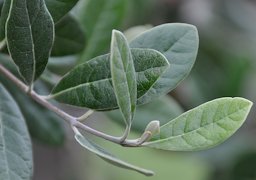 Fig. 2  Leaves of the Feijoa sellowiana 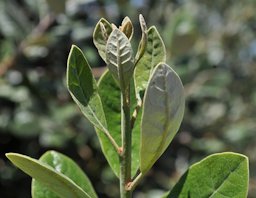 Fig. 3  New growth 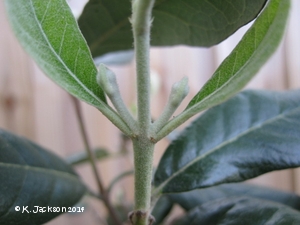 Fig. 6  Buds forming 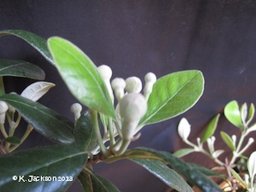 Fig. 7 Flower buds 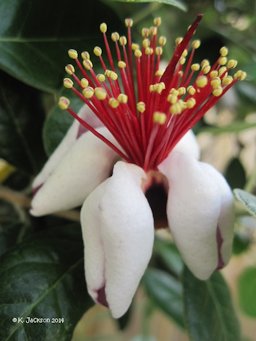 Fig. 8  Flower 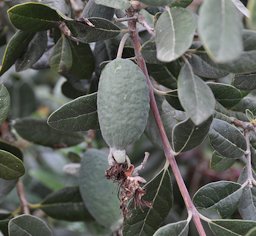 Fig. 11  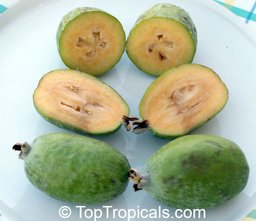 Fig. 12  Pineapple guava fruit 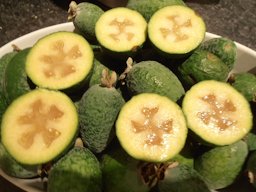 Fig. 13 Pineapple guava fruit 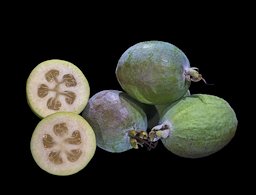 Fig. 14  Pineapple guava 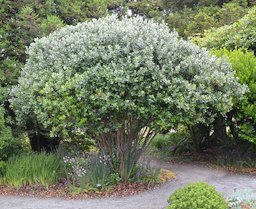 Fig. 15  Multitrunk 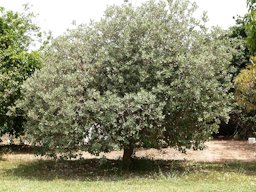 Fig. 18  Single trunk 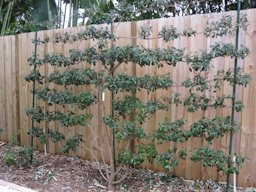 Fig. 16  Guava trained as an espalier 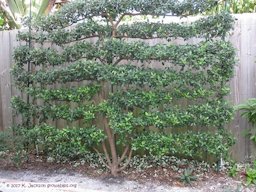 Fig. 17  Same espaliered guava four years later  Fig. 18  Feijoa orchard in the Dax, Landes, France, end of October, with fallen ripe fruit, which is ready to be picked and eaten. 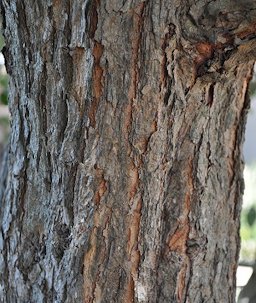 Fig. 19 Bark of a mature tree 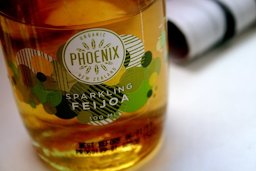 Fig. 20 Phoenix sparkling feijoa, New Zealand 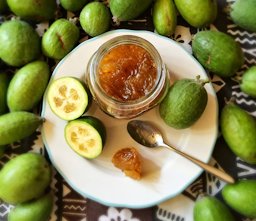 Fig. 21  Feijoa marmallata 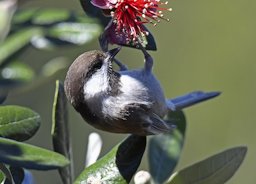 Fig. 25  Busy, busy, always busy. Chestnut-backed chickadee on a pineapple guava blossom. 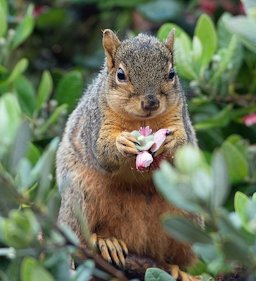 Fig. 26  Love those blossoms! The pineapple guava blossoms are very popular with many critters, including the Fox squirrels. |
Scientific
name Feijoa sellowiana (O.Berg) O.Berg Pronunciation fay-JOE-uh sell-oh-wee-AY-nuh 3 Common names English: pineapple-guava; German: Feijoa; Portuguese: goiaba-do-campo, goiabeira-serrana; Spanish: falso guayabo, guayaba brasilera, guayaba chilena; Swedish: feijoa 4 Synonyms Acca sellowiana (O.Berg) Burret; Acca sellowiana var. rugosa (Mattos) Mattos; Feijoa obovata (O. Berg) O. Berg; F. sellowiana f. elongata Voronova; F. sellowiana var. rugosa Mattos; F. schenckiana Kiaersk.; Orthostemon obovatus O. Berg 10 Relatives Blue grape (Myrciaria vexator), cattley guava (Psidium cattleianum), cherry of the Rio Grande (Eugenia aggregata), grumichama (E. brazileinsis), guava (P. guajava), jaboticaba (Myrciaria spp.), pitomba (E. luschnanthiana), stoppers (Eugenia spp.) 7 Family Myrtaceae (myrtle family) Origin Native to extreme southern Brazil, northern Argentina, western Paraguay and Uruguay 1 USDA hardiness zones 8-11 2 Uses Fruit; ornamental specimen; hedge; screen 3 Height 10-15 ft (3-4.6 m) 3 Spread 10-15 ft (3-4.6 m) 3 Crown Spreading; irregular; upright/erect; round 3 Plant habit Compact and erect or spreading 7,8 Growth rate 24 in. (61 cm) per season Longevity Less than 50 years (production life 30-40 years) Trunk/bark/branches Bark light green or red brown; exfoliating or scaly Pruning requirement Needed for strong structure 3 Leaves Evergreen; stiff, shiny green above, light grayish-green underneath 8 Flowers Thick white petals; scarlet stamens; edible; flowers in spring; has perfect flowers; showy 8 Fruit Gray-green; oval; ripe fruit rarely found on bush, usually drops 8 Season Sept. through Nov. 2 USDA nutrient content pdf Light requirement Partial sun or partial shade; full sun 3 Soil tolerances Sand; loam; slightly alkaline; acidic; well-drained; well-drained 3 pH preference 5.5-7.0 2 Drought tolerance High Aerosol salt tolerance High Soil salt tolerance Very good 8 Cold tolerance Hardy to 14 °F (-10 °C) 8 Plant spacing 7-14 ft (2-4 m) 2 Roots Not a problem Invasive potential * It is not considered a problem species and may be used in Florida 3 Pest resistance Free of pests or diseases of major concern 3 Known hazard None known Reading Material Growing Feijoa Fruit in Florida, University of Florida pdf Feijoa sellowiana: Feijoa, University of Florida pdf Fact Sheet on the Feijoa, California Rare Fruit Growers Feijoa sellowiana, Floridata Feijoa, Fruits of Warm Climates The Feijoa (Feijoa Sellowiana, Berg), Manual Of Tropical And Subtropical Fruits Taxonomy Feijoa sellowiana Berg is from the genus which the German botanist, Ernst Berger, named after João da Silva Feijó, a Portuguese naturalist, and the specific name honors Friedrich Sellow, a German who first collected specimens of feijoa in southern Brazil. 6 Origin The feijoa is native to extreme southern Brazil, northern Argentina, western Paraguay and Uruguay where it is common wild in the mountains. 1 Description Feijoa sellowiana, or Pineapple Guava, is a gray-green evergreen shrub or tree (depending on pruning) which produces small, tasty fruit in late summer and early fall. The plants can be pruned to form a hedge or a small tree and will withstand several degrees below freezing. 3 If gardening were an Olympic sport, pineapple guava might be a contender for best all-around shrub. This attractive evergreen can be grown throughout Florida and is a favorite for its attractive silvery foliage, unusual flowers, and edible fruits. 1 Pineapple guava was named a Florida Garden Select plant in 2009 by the Florida Nursery Growers and Landscape Association. It can be grown anywhere in Florida and is especially suited for coastal area gardens because it tolerates salt spray. The plant is also commonly known as feijoa. It appears to be free of serious pests and diseases. 1 It is a warm-temperate to subtropical plant that also will grow in the tropics, but requires at least 50 hours of winter chilling to fruit, and is frost-tolerant. When grown from seed, feijoas are noted for extremely slow growth during their first year or two, and young plants, though cold tolerant, can be very sensitive to high wind. 2 Leaves The evergreen, egg-shaped leaves are 2 to 3 inches long and have silvery, slightly fuzzy undersides that often give the entire plant a slight bluish cast. 1
Fig. 4. A. sellowiana in Dunedin Botanic Garden, Dunedin, New Zealand Flowers The flowers appear from April through May and are 1 to 2 inches across. The fleshy petals are white or a soft pink and the stamens are a striking burgundy. An extra perk is that the flowers are edible and can be added to salads and other dishes. 1 Flowers progress from early opening to senescence in eight days. 2 Chilling appears to be required for flower bud initiation, although the amount required is poorly studied and cultivar dependent. Estimates are documented at between 50–200 hours. 2
Pollination Plant at least three varieties for proper cross pollination. 8 It has been said that feijoa pollen is transferred by birds that are attracted to and eat the flowers, but bees are the chief pollinators. Most flowers pollinated with compatible pollen show 60 to 90% fruit set. Hand pollination is nearly 100% effective. Two or more bushes should be planted together for cross-pollination unless the cultivar is known to be self-compatible. Poor bearing is usually the result of inadequate pollination. 9 Fruit The fruit, maturing in autumn, is green, ellipsoid, and about the size of a chicken egg. It has a sweet, aromatic flavor, which tastes like pineapple, apple and mint. The flesh is juicy and is divided into a clear, gelatinous seed pulp and a firmer, slightly granular, opaque flesh nearer the skin. 6 Feijoa fruit has a distinctive, potent smell that resembles that of a fine perfume. The aroma is due to the ester methyl benzoate and related compounds that exist in the fruit. 12 Also note that fruit set may be low in extreme southern Florida, since the plants fruit better when they’re exposed to cold temperatures for a certain period of time each winter. Extreme heat in summer may also cause them to drop fruit prematurely. 1 Fruit thinning is not typically done for feijoa. Fruit matures between 20 and 26 weeks after flowering and mostly overlaps with the rainy season in Florida. 12 Varieties Harvesting The egg-shaped fruits begin to mature and ripen, starting out gray-green and then turning a reddish-brown. They fall off the plant when they’re ready to eat, though they can be picked earlier and left to ripen on a kitchen counter. The fruit emits a strong long-lasting perfume, even before it is fully ripe. 1 The first harvest of fruit happens 2–4 years after planting, and plants reach maturity and full fruiting at 8–10 years. Harvest begins as early as September and lasts through November, depending on variety. The estimated production life of feijoa is 30–40 years, but specific data is not available for Florida. 12 Propagation Gardeners who want to enjoy fruit may wish to purchase one of the named self-fruiting varieties like ‘Coolidge’ that have shown to perform well in Florida. Pineapple guava can be grown from seed, but seedlings are slow growing and may not produce high quality fruit. 1 When grown from seed, feijoas are noted for extremely slow growth during their first year or two. 2 Seeds are separated by squeezing the seedy pulp into a container, covering with water, and letting the liquid stand for 4 days to ferment. The seeds are then strained out and dried before sowing. The seeds will retain viability for a year or more if kept dry. Germination takes place in 3 weeks. The plant fruits in 3 - 5 years from seed. 9 Clonal propagation is a challenge in feijoa, with most reports indicating limited success. Grafting is difficult because the wood is hard and splits easily. Successful grafts have been obtained using cleft and whip-and-tongue grafts. Air layering and ground layering of low-hanging branches are additional options. 2 Clmate Feijoa trees cannot stand cold winters. Frosts can also damage the fruit, which ripen during late autumn. Symptoms of frost-damaged fruit can be seen internally as water-soaked regions in the flesh on the exposed upper surfaces of the fruit, with the affected tissue beginning to brown within a few hours of the frost. 14 Planting The feijoa requires little care beyond good soil preparation before planting. Subsequent cultivation is inadvisable because of the plant's shallow, fibrous root system which should be left undisturbed. If planted for its fruit, fertilizer should be low in nitrogen to avoid excessive vegetative growth. It should be watered liberally during hot, dry spells. 1 In their natural habitat, feijoas can survive on nutrient-poor and acid soils not tolerated by many crops. Best results, however, are obtained with soils that are at least reasonably well drained and slightly acid. 14 Pruning Pineapple guava can easily be pruned to form a dense hedge or trained into a small tree with a single trunk. Left unpruned, it can reach up to 15 feet tall and 15 feet wide. For added interest, try training it as an espalier (Fig. 16,17). The fruit is borne on young growth. The plant has a tendency to become very leggy. These two factors indicate that pruning should begin early on young plants, to encourage them to become bushy with lots of fruiting tips. Prune the fruiting branches back as soon as fruit is harvested, to allow time for new shoots to grow for the next harvest. 13 The pruning pattern for mature trees involves the following stages, undertaken in the following sequence: • Skirting involves removal of 50–75 cm of the base of the canopy by cutting back low branches and completely removing those that are growing downwards from the parent branch. • Height control involves limiting the height of the mature tree to about 2.5 m, so that fruit can be routinely hand- harvested. This is achieved by applying two or three heavy pruning cuts each winter, in towards the centre of each tree, on 3- to 4-year-old wood, targeting the tallest or most vigorous branches for complete removal. • Branch thinning is carried out in winter, as with juvenile trees, to keep the canopy reasonably open. The particular aim is to provide access for birds required for pollination so that they can move freely amongst the branches during flowering, and also to enhance penetration of light and orchard sprays into the tree. 14 Fertilizing If granular fertilizer is used, small amounts (0.5 lb/plant to 1 lb/plant for young plants and no more than 2 lb for mature plants) should be made from late winter through fall on 4-to-6-week intervals. 2 If growing feijoas for their fruit, do not add fertilisers high in N. 13 Irrigation Although pineapple guavas are moderately drought tolerant, they need regular watering to produce high-quality fruit. Depending on your climate and soil type, give established trees a deep soaking every week or two during summer. Water young trees oftener and make sure you soak the rootball thoroughly. Pests/diseases In the southeastern United States, feijoa has no reported consistent pests or pathogen threats. 2 Food Uses Feijoa has a distinct, strong fruity flavor and aroma reminiscent of pineapple mixed with the presence of other fruity, sweet-sour notes. 2 When preparing feijoas for eating or preserving, peeling should be immediately followed by dipping into a weak salt solution or into water containing fresh lemon juice. Both of these methods will prevent the flesh from oxidizing (turning brown). The flesh and pulp (with seeds) are eaten raw as dessert or in salads, or are cooked in puddings, pastry fillings, fritters, dumplings, fruit-sponge-cake, pies or tarts, or employed as flavoring for ice cream or soft drinks. Surplus fruits may be peeled, halved and preserved in syrup in glass jars, or sliced and crystallized, or made into chutney, jam, jelly, conserve, relish, sauce or sparkling wine. 6 The thick petals are spicy and are eaten fresh by children and sometimes by adults. The petals may be plucked without interfering with fruit set. 6 The pulp can be a substitute in a recipe calling for banana or apple. 12
Fig. 22. Feijoa pannacotta at Vino Vino; the wonderful world of Feijoa in dessert, in vodka, all over the place Fig. 23. Guava pineapple, refreshing Fig. 24. Spiced pineapple guava (Feijoa) chutney Other Uses Processed feijoa products are often used to promote sales of the fresh fruit as they retain much of the distinctive appeal of fresh feijoas. The feijoa flavour is a new flavour that is reasonably stable during processing. High quality processed feijoa products, for example frozen desserts and drinks such as feijoa wine or juice products, have been developed for several markets. Feijoa wine has been sold in small quantities to Asian markets and feijoa juice is currently used in a range of successful commercial blends in New Zealand. Freeze-dried feijoa chips are also used in breakfast cereal mixes. 14 An infusion is prepared from the leaves and this is administered in traditional medicine as a somewhat astringent drink to cure dysentery and cholera, especially in children. Homeopathic pharmacies sell ‘feijoa tea’ for this purpose. The more potent infusion, however, is prepared from the dried skins of feijoa fruit. 14 The feijoa pulp is used in some natural cosmetic products as an exfoliant. 2 The wood is moderately heavy, compact, elastic, splits easily, very durable even in adverse conditions. It can be used for small works, posts, stays etc. The wood is used for fuel and to make charcoal. 11 General As a rule wild fruits, or those which have not been improved by cultivation, are seedy or have scanty flesh. The feijoa, taken directly from the wild, is remarkable for the minute size of its seeds, its abundance of flesh, and its delicious perfumed flavor. 5 Further Reading Feijoa (Feijoa sellowiana), Neglected Crops Feijoas, Sub-tropical Fruit Club of Qld Pineapple Guava Botanical Art List of Growers and Vendors |
||||||||||||||||
| Bibliography 1 "Pineapple Guava." Gardening Solutions, AskIFAS, gardeningsolutions.ifas.ufl.edu/plants/trees-and-shrubs/shrubs/pineapple-guava.html. Accessed 18 Jan. 2014. 2 Folta, et al. "Growing feijoa fruit in Florida." Horticultural Sciences Dept., UF/IFAS Extension, HS1424, Original pub. Dec. 2021, AskIFAS, edis.ifas.ufl.edu/publication/HS1424. Accessed 12 Apr. 2023. 3 Gilman, Edward, F., and Dennis G. Watson. "Feijoa sellowiana: Feijoa." Environmental Horticulture, UF/IFAS Extension, ENH408, Pub. date Nov. 1993, Reviewed Feb. 2014, AskIFAS, edis.ifas.ufl.edu. Accessed 5 Apr. 2015. 4 "Acca sellowiana." USDA Germplasm Resouces Information Network, ars-grin.gov. Accessed 5 Apr. 2015. 5 Popenoe, Wilson. Manual Of Tropical And Subtropical Fruits. 1920, London, Hafner Press, 1974. 6 Fruits of Warm Climates. Julia F. Morton, Miami, 1987. 7 Boning, Charles R. Florida's Best Fruiting Plants- Native and Exotic Trees, Shrubs, and Vines. Pineapple Press, Inc. Sarasota, 2006. 8 Maxwell, Lewis S., and Betty M. Maxwell. Florida Fruit. Lewis S. Maxwell, Tampa, 1991. 9 "Feijoa." California Rare Fruit Growers, 1996, crfg.org. Accessed 18 Jan. 2014. 10 "Feijoa sellowiana (O. Berg) O.Berg synonyms." Plants of the World Online, Kew Botanic Gardens, powo.science.kew.org/taxon/urn:lsid:ipni.org:names:596467-1. Accessed 13 Apr. 2023. 11 Lorenzi, Harri. Brazilian Trees, a Guide to the Identification and Cultivation of Brazilian Native Trees. Vol. 1. 4th ed., Nova Odessa, Instituto Plantarum de Estudos da Flora, 2002. 12 "Feijoa sellowiana." Wikipedia, www.wikipedia.org/wiki/Feijoa_sellowiana. Accessed 13 Apr. 2023. 13 "Feijoa, Pineapple Guava, Acca (Feijoa) sellowiana." The rare Fruit Club WA, www.rarefruitclub.org.au/Feijoa.htm. Accessed 13 Apr. 2023. 14 The Encyclopedia of Fruit & Nuts. Edited by Jules Janick and Robert E. Paull, Cambridge, CABI, 2008. Video v1 feralkevin. "Feijoa flowers taste like candy." YouTube, (CC0), www.youtube.com/watch?v=Vwx0Z8RdNxQ. Accessed 13 Apr. 2023. Photographs Fig. 1 HortReseach. "Feijoa." Wikipedia, 2006, www.wikipedia.org. Accessed 6 Dec. 2014. Fig. 2,3,11,15,19 Ritter, M., et al. "Feijoa sellowiana, Photo Record 1995-2015." SelecTree, selectree.calpoly.edu. Accessed 5 Apr. 2015. Fig. 4 Golik, Krzysztof. "Acca sellowiana in Dunedin Botanic Garden, Dunedin, New Zealan." Wikipedia Commons, 17 Nov. 2017, (CC BY-SA 4.0), commons.wikimedia.org/wiki/File:Acca_sellowiana_03.jpg. Accessed 12 Apr. 2023. Fig. 5,6,7,8,9,16 Jackson, Karen. "Pineapple guava Series." 2014, www.growables.org. Fig. 10 pamsai. "Feijoa: unusual flowers." Wikipedia Commons, via Flidkr, 27 July 2011, (CC BY-SA 2.0), commons.wikimedia.org/wiki/File:Feijoa_fruits.jpg. Accessed 12 Apr. 2023. Fig. 12 "Feijoa sellowiana." Top Tropicals, toptropicals.com. Accessed 7 Dec. 2014. Fig. 13 Sarang. "Some feijoas." Wikipedia Commons, 15 Apr. 2013, Public Domain, commons.wikimedia.org/wiki/File:Feijoa_fruits.jpg. Accessed 12 Apr. 2023. Fig. 14 Descouens, Didier. "Pineapple guava (Acca sellowiana syn: Feijoa sellowiana, Myrtaceae) fruits. Fronton, Haute -Garonne France." Wikipedia, 2013, www.wikipedia.org. Accessed 6 Dec. 2014. Fig. 17 Jackson, Karen. "Pineapple guava Series." 2017, www.growables.org. Fig. 18 Arn. "Feijoa orchard in the Dax, Landes, France, end of October, with fallen ripe fruit, which is ready to be picked and eaten." Wikimedia Commons, 2 Nov. 2015, (CC BY-SA 4.0), commons.wikimedia.org/wiki/File:Verger_de_Feïjoa_fruits_tombés_à_terre.jpg. Accessed 13 Apr. 2023. Fig. 20 Sarah-Rose. "Mm. Phoenix Sparkling Feijoa." Flickr, 10 Apr. 2009, (CC BY-SA 2.0), www.flickr.com/photos/21692054@N00/3433815592. Accessed 12 Apr. 2023. Fig. 21 Parrottino, Mariaelena. "Feijoa marmallata." In Natural, 2 Oct. 2017, (CC BY-NC-ND 3.0), www.innaturale.com/wp-content/uploads/2017/10/marmellata-feijoa.jpg. Accessed 13 Apr. 2023. Fig. 22 Deepwarren. "Feijoa pannacotta at Vino Vino. The wonderful world of Feijoa in dessert, in vodka, all over the place." Flickr, 2011, (CC BY-NC 2.0), www.flickr.com. Accessed 26 June 2017. Fig. 23 Chan, Vernon. "Guava pineapple. Refreshing!" Flickr, 2012, (CC BY-NC 2.0), www.flickr.com. Accessed 26 June 2017. Fig. 24 andiezoe. "Spiced Pineapple Guava (Feijoa) Chutney." Flickr, 2012, (CC BY-NC 2.0), www.flickr.com. Accessed 26 June 2017. Fig. 25 Greenberg, Doug. "Busy, busy, always busy. Chestnut-backed chickadee on a pineapple guava blossom." Flickr, 2017, (CC BY-NC 2.0), www.flickr.com. Accessed 26 June 2017. Fig. 26 Greenberg, Doug. "Love those blossoms! The pineapple guava blossoms are very popular with many critters, including the Fox squirrels." Flickr, 2017, (CC BY-NC 2.0), www.flickr.com. Accessed 26 June 2017. * UF/IFAS Assessment of Non-native Plants in Florida's Natural Areas ** Information provided is not intended to be used as a guide for treatment of medical conditions. Published 18 Jan. 2014 LR. Last update 14 Apr. 2023 LR |
|||||||||||||||||
